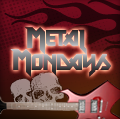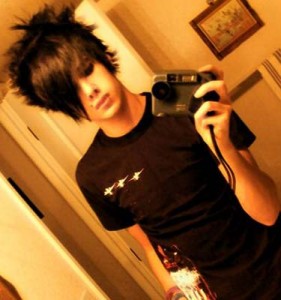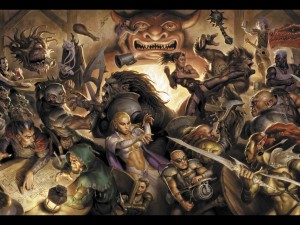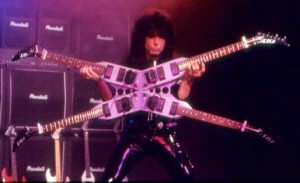Metal Monday: The (Somewhat) Definitive Metal Glossary
posted in: Rock
 Have you ever been nerding it up about your favorite metal band, talking to someone much less versed than you in the world of metal, and see the blank stare on their face as you use words they don’t understand? I thought so, which is why I’m here to help. I’ve comprised a very handy guide you can provide to all your friends that outlines the common terms associated with metal music. Nouns, verbs, titles, adjectives“you name it, I’m covering it. With no further ado, I give you the (somewhat) definitive metal glossary, presented neatly in alphabetical order.
Have you ever been nerding it up about your favorite metal band, talking to someone much less versed than you in the world of metal, and see the blank stare on their face as you use words they don’t understand? I thought so, which is why I’m here to help. I’ve comprised a very handy guide you can provide to all your friends that outlines the common terms associated with metal music. Nouns, verbs, titles, adjectives“you name it, I’m covering it. With no further ado, I give you the (somewhat) definitive metal glossary, presented neatly in alphabetical order.
Black – A genre of metal played by people obsessed with counter culture who wear black clothing almost exclusively. Notorious for being supposed Satanists and recording extraordinarily low quality albums. Solid chance anyone who makes it knows far too much about Norway, or actually resides there.

Average black metal musicians
Blackened – Any music referred to as “blackened” is really only intended to be labeled as “more evil” than the other bands in their main genre. Primary examples include blackened thrash metal and blackened death metal.
Breakdown – A tool used by -core bands in place of true musical transitions in their song.
Brutal (br00tal) – The word brutal has two uses and definitions in the world of metal. Firstly, it is a wildly overused term to describe the degree to which something is heavy and loud (e.g. “Dude, that’s so brutal”), but more recently, has been used mockingly do describe the degree to which a band has taken their level of heaviness and loudness to a silly degree (e.g. “Dude, that’s so br00tal”). Most often used by amateur metal bloggers who refer to themselves as music journalists.
-core – The label “-core” is a suffix added to just about any style of metal that includes breakdowns. Can be applied almost universally. Primary examples include metalcore, deathcore, mathcore and thrashcore.
Crushing – At any point where you need to stress that something is especially brutal, crushing is a strong substitute. Primarily used to refer to breakdowns, it can also be applied to nearly any other facet of metal music (e.g. “That was the most crushing breakdown I’ve heard all day. Totally rad.”)
Death – From an outside and uninformed view, this applies to any style of metal that features low growling, fast tempos and down-tuned guitars. Though metalheads may try to refute this, the truth is that it is not much more than that. Spawned mostly from Slayer’s musical style, the genre was given its name by pioneers Death, whom do not even fall directly under the current death metal tag (they’re more often tagged as progressive or technical death now).
Deathcore – Almost entirely dissimilar from the classic definition of death metal and hardcore”the genres deathcore is derived from”the genre now refers more to a visual style accompanied by music that may or may not feature down-tuned breakdowns. Popular examples include: As Blood Runs Black, Emmure, Winds Of Plague, Oceano, Job For A Cowboy, The Black Dahlia Murder, Between The Buried And Me, et. al.
Djent – A genre of music based entirely from the staccato, often rhythmically complex guitar style popularized by Meshuggah in the 1990s. Major style influences on the current landscape of the genre are Textures, Fellsilent, and SikTh. Current djent musician population: approximately eight musicians. Current number of djent bands: approximately forty-two bands. Popular djent bands include: TesseracT, Periphery, Veil of Maya and most other acts on Sumerian Records.
Doom – The most slow and depressing style of metal that exists. Rips off Black Sabbath riffs and accompanied by strange, mysterious personalities and images. A litany of nearly identical fusion offshots exist (e.g. death doom, stoner doom, funeral doom, etc.). Examples include Candlemass, Pentagram and Pagan Altar.
Double bass – A term for a specific drum technique, it is most often used to refer to any kick drum pattern that seems fast (often gauged by how fast the listener believes they can play a kick drum with one foot).

Emo kid in its natual habitat
Emo – A derogatory term tough metalheads use to refer to kids with swoopy hairstyles or people who appear meek. Also used to refer to any style of music that sounds whiny to the listener.
Evil – Evil is the ideological basis for many songs, albums and bands throughout metal history. Perhaps one of the most overused topics in metal, the largest culprits of this are doom, death and black metal bands.
Grindcore – One of the more intense styles of metal, grindcore often features sections of music that make little to no sense in succession. One of few consistent subject matters of the genre are of political basis. Many grindcore bands primarily write songs that struggle to reach a minute in length and feature titles vaguely related to the song (at best). Popular bands include: Brutal Truth, Cattle Decapitation and Napalm Death. Also anything Scott Hull touches, as grind exudes from his very being.
Hardcore dance – The act of fighting the air in a mosh pit, often referred to by outsiders as “moshing” (but any decent metalhead knows these things are not the same). Potentially mistaken for karate practice. Whichever the case, it is safest to avoid a hardcore dance area at all costs.
Heavy – Heavy metal is a style of metal for old dudes. The term heavy has also been used to describe seemingly every metal style under the sun, as well as those not under the sun (black metal folk, I’m looking at you).
Kvlt (cult) – The ultimate goal of all black metal musicians is to be the most kvlt member of their community. Kvlt activities include (but are not limited to): worshipping Satan, being pale, murdering their fellow black metal folk, misunderstanding the reason why church burnings happened in the first place, never wearing anything that is a color other than black or white, sacrificing animals, living in the middle of nowhere in Norway, not being happy, wearing clown-like facepaint, wearing medieval garb, obsession with the dark and cold.
Math – Math metal or mathcore is a style of metal made for robots, by robots. Not listenable to human ears. Potential robots/androids/terminators include: The Dillinger Escape Plan, Ion Dissonance, Daughters.

Typical mosh pit goer
Mosh – The physical activity manifestation of rage/energy at a metal show. Often times moshing is the most calories a metalhead burns as part of his/her regular routine. Generally not advised for the weak, or for those grossed out by giant, sweaty, smelly dudes. That said, most mosh pits will often help to pickup any people who fall, avoiding death by trampling (after all, metalheads want to keep their combat boots clean).
New thrash/rethrash – The modern version of the first widely popular/respected metal genres. A vast majority of musicians seem stuck in the ’80s, and often look like they were extras in the Heavy Metal Parking Lot documentary. Lyrical content is almost exclusively related to drinking, partying and zombies/nuclear waste accidents. Hated by many old metal dudes and classic thrashers.
Noodling – Pure fret masturbation, often seen as egregious displays of technical prowess. Infamous fret masturbators include: Yngwie Malmsteen, Steve Vai, etc.
Nu metal – Least popular style of metal in history, as deemed by metalheads. Of the most popular as deemed by the public at large. Considered a blemish on the history of metal by many, sometimes considered a direct precursor to deathcore (most obvious link being the lineage from Limp Bizkit to Emmure).

Visual depiction of all power metal
Power – Power metal is metal for nerds. Lyrics all sound as though you’re reading from a Tolkien novel. Always fast, sometimes featuring full orchestras and narration from Christopher Lee (aka Saruman).
Progressive – A genre tag synonymous with “weird” or “off-color” that is often arbitrarily used to describe bands with songs that eclipse ten minutes. The most prominent feature of bands described as progressive is excessive instrument noodling and wankery.
Raw – Raw is the more polite and politically correct way to refer to the god-awful production, mixing and mastering of many black metal albums. Low fidelity is also acceptable in many cases.
Satanic – Along with evil, this is the underlying ideology behind many black metal bands’ creations. The more Satanic you/your band figures out how to be, the more evil and kvlt you become/are perceived.
Screamo – A term applied to emo kids who play music that appears to mimic the more intense styles of metal. Playing this style of music is considered a sign of weakness so participants often try to hide their screamo past.
Singing – In the metal world, the term “singing” can refer to any of the following things: grunting, growling, yelling, groaning, moaning, gurgling, spitting, wailing, squealing, burping, screaming and, yes, actual singing.

Shredding done right
Shredding – Playing as many notes on a guitar as you possibly can in as short a time as possible. In many cases, it matters not what these notes are (though the scale-playing approach is quite popular). A necessary requisite to being in a popular and successful metal band.
Slam – The part of a breakdown or metal song that is emphasized by a louder section or as bass drop. Designed to make you want to pummel anything and everything near you, used primarily by brutal death metal and deathcore.
Sludge – The cousin of doom metal and hardcore punk, this genre sounds exactly like a thick, viscous matter should. Similar to doom metal, they’re all essentially ripping off Black Sabbath, but instead of getting more sad, they get more angry and drugged-out. Popular bands: Crowbar, Down, High On Fire.
Solo – The solo section of the song where the guitarist (typically) embarks on a quest of pure, unadulterated wankery. Can last for any amount of seconds, minutes or hours as long as you play fast enough. Remember, channel your inner Yngwie.
Symphonic – Any single metal song ever created instantly becomes part of the “symphonic” sub-sub-genre of metal. Applies to all genres across the board.
Technical – Like symphonic, this is a sub-sub-genre that can be applied to any music that features an above average level of difficulty, wankery and math-ness. See also: Math metal/mathcore (aka metal for robots).
Thrash – Originally envisioned to be some sort of amalgamation of old school heavy metal and fast punk music, thrash ultimately ended up being a genre led by four dissimilar bands (Slayer, Metallica, Megadeth and Anthrax). There are more than four bands in the thrash world, but almost no one knows or cares about them.
Wailing – The name of the vocal style featured mostly in old school heavy metal (aka metal for old people) and power metal. It’s the more polite and politically correct way to say someone sings like a woman.
